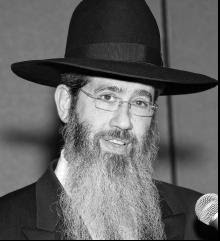Recently a father asked Rabbi Dovid Goldwasser the following sheiloh. He was sitting at the Shabbos seudah with the family gathered around the table. As he started singing lively zemiros, he began to tap on a sefer that was on the table in front of him. His young son, 4-1/2 years old, looked up at him in wonderment, and said, “Totty, the sefer is heilig!” It didn’t seem right to the son that the father was tapping on a sefer.
The father repeated the story to Rabbi Dovid Goldwasser and asked whether his young son had indeed raised a valid point.
Kovod seforim is something of major import. The kovod that one has for a sefer is really the kovod that one has for limud Torah, for talmidei chachomim, and even the Torah itself! The basis of our halachos is derived from Mesechta Eruvin 98a:
Hoyoh korei b’rosh hagag … if one was reading on top of a roof, which is a reshus hayachid (a private domain), and one end of the book rolled from his hand into the reshus harabbim (the public domain) below … he should turn it over on its written side so that the lettering is not exposed.
Rashi says because it is an embarrassment for the sefer to lie open and be exposed to the streets, therefore he should turn the side with the letters to the wall.
The Gemara asks: Is it permitted to turn sifrei kodesh on their written side? The Braisa teaches us that those who write Torah, Tefillin and Mezuzos were not allowed to turn the writing face-down. But rather, a person should spread a garment over it. The Gemara answers that it was not possible to cover this particular sefer because there was no garment readily available that was large enough. Therefore, in order to avoid disgrace to the sefer, it’s better that he does not leave the writing face-up.
In Yoreh Dei’ah Siman 277 we learn that if a person wrote a page in fresh ink and he wants to leave it to dry, he should not turn the page with the writing side face-down, even though his intent is that dirt should not come upon the writing. It is nevertheless considered to be degrading and therefore one should rather place a covering on the page for protection.
The Taz in Yoreh De’ah Siman 271 makes a strong statement concerning kedushas haseforim. “Whoever is lenient regarding this matter, in the future will have to give din v’cheshbon.”
In the Sefer Maavir Yabok it is written that seforim that are published have the kedusha of a sefer that was written with a quill. Furthermore, a person should not do anything in the room where there are seforim that would be considered disrespectful to the seforim, unless the sefer is enclosed in a kli toch kli – in two coverings -- or if there is a mechitzah of 10 tefochim between the person and the seforim.
The Sefer Yeshuas Chochmah writes that there are those who are noheg to put a sefer on top of an open sefer when they wish to interrupt their learning. He writes that this is forbidden and cites the Pischei Teshuvah in Yoreh De’ah Siman 282, in the name of the Chamudei Daniel, that it is forbidden to put a sefer into another sefer in order to hold one’s place so that he will not have to find it at a later point.
Some say that if closing the sefer will cause bitul Torah then it may be possible to utilize another sefer to keep one’s place.
This is according to the Taz in Yoreh De’ah 282 that forbids putting a sefer on top of another sefer in order to elevate the sefer, for that is making mundane use out of a sefer, as if it were a piece of wood or a stone.
However, the Mogen Avrohom writes that it is permissible to take a sefer and put it under another sefer to raise it.
If the sefer was already on the table and the person places his sefer on top of it in order to elevate his sefer, then it’s permissible. However, one should be careful about actually taking a sefer to place it underneath.
In general, one should be careful about leaving a sefer open when he leaves the room where he is learning. In the Sefer Zikoron of HaGaon R’ Chaim Kanievsky, shlita, he writes that leaving a sefer open is one of the things that a person should be careful about because it can bring a person to shichecha – forgetfulness. Therefore, a person should remember to close the sefer, or at least to cover it, when he is going to take leave his sefer. This accomplishes two things: (1) It is proper kovod for the kedusha of the sefer and (2) it will not cause forgetfulness.
It is written in the Sheilos U’Teshuvos of the Yaskil Avdi that it is forbidden to leave a sefer open even for a short time. He writes that this is even for the amount of time that it would take ink to dry. He cites the Shach that there is a malach named Shomer Dafim that is appointed over those who leave a sefer open, who causes one to forget. It would seem as though this malach looks for opportunities to fulfill his mission. And as soon as he sees it, he recognizes his opportunity to act.
There is a question as to when this particular din applies. Is it merely if a person needs to leave the room for a moment, and he will certainly return immediately? What if he merely needs to get up to search for a different sefer? Or is it if he goes outside of the bais medrash?
The Aruch HaShulchan writes in 277 it’s specifically when a person goes out to the street. Then a person needs to cover the sefer or close it. However, a person who goes from room to room, or even from the courtyard to the street, not for an extended period of time, does not have to worry. It depends upon what the person is going to do when he leaves the sefer, i.e., he is leaving only for a few moments, and his intent is to come back and resume his learning.
Before the fame of the great tzaddik, the Rebbe R’ Elimelech of Lizhensk, had spread throughout the world, a man who had just finished davening took a seat at a small desk on the side of the bais medrash. These were the old-fashioned desks that used to have a compartment underneath the seat. The man noticed what looked like a sefer sticking out from under the seat. He took it out and looked somewhat skeptically at the new sefer. What is this Noam Elimelech? “Who is the one who wrote it?” he asked one of the talmidei chachomim who happened to be passing by. The talmid chochom answered him, “If you would know who the Noam Elimelech is, you would put the sefer on top of the chair, and you would crawl into the compartment!”
Thursday, April 10, 2008
Subscribe to:
Posts (Atom)


